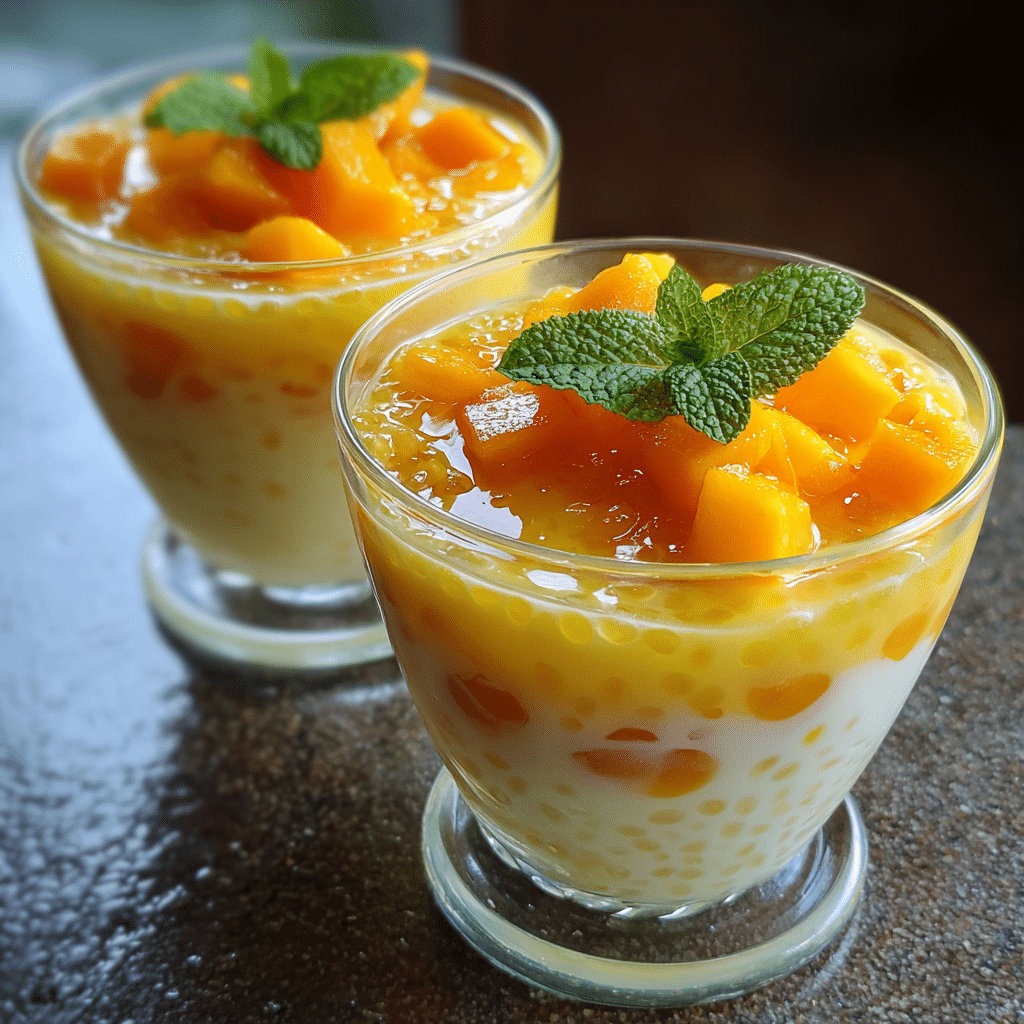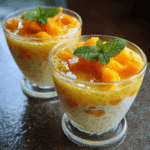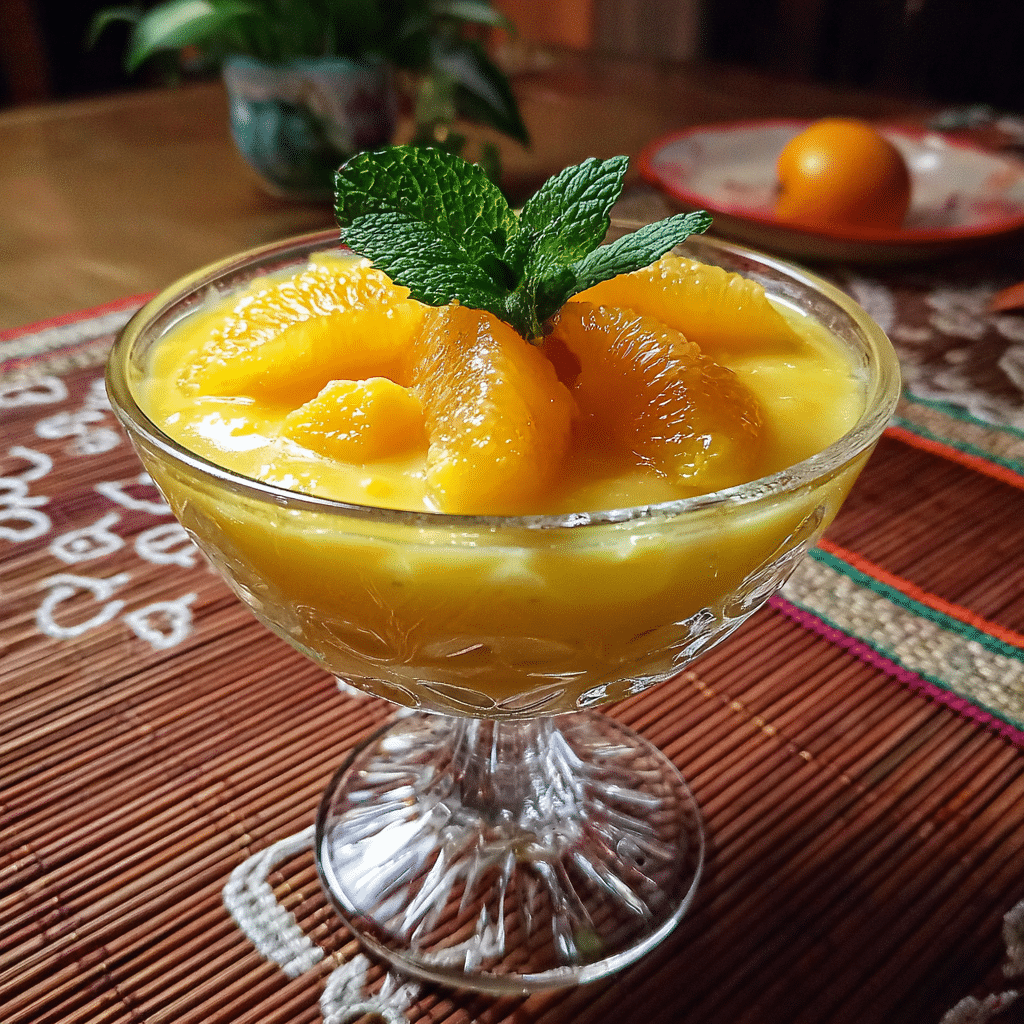Looking for a refreshing and creamy dessert that blends tropical flavor with satisfying texture? The mango sago recipe is your perfect go-to treat. Popular across Asia, especially in Hong Kong, Taiwan, and Southeast Asia, mango sago combines fresh mangoes, chewy tapioca pearls (sago), and a creamy coconut milk base. This article walks you through everything—from choosing the right mango to perfecting that silky consistency.
Don’t miss our Black Bean Noodles Vegetarian Recipe for another Asian-inspired culinary adventure.

Let’s dive into this fruity delight and discover how to master mango sago at home.

Mango Sago Recipe – The Ultimate Guide to a Creamy Tropical Dessert
- Total Time: 30 minutes
- Yield: 4 servings 1x
Description
This mango sago recipe is a light, creamy, and refreshing tropical dessert made with ripe mangoes, chewy sago pearls, and rich coconut milk. It’s a quick no-bake treat popular in Asian cuisine, perfect for hot summer days or dinner parties.
Ingredients
2 ripe mangoes (peeled and cubed)
½ cup small sago pearls
1 cup full-fat coconut milk
1 tablespoon honey or maple syrup (optional)
1 cup water (for blending mango)
Pomelo segments or mint leaves (optional garnish)
4 cups water (for boiling sago)
Instructions
1. Cook the sago: Bring 4 cups of water to a boil. Add sago pearls and stir gently for the first few minutes to prevent sticking. Simmer for 10–12 minutes until nearly translucent.
2. Cool sago: Turn off the heat and let sit covered for 5 minutes. Then drain and rinse under cold water to stop cooking.
3. Make mango puree: Blend cubed mangoes with 1 cup water and 2 tablespoons coconut milk until smooth. Add honey if additional sweetness is needed.
4. Chill: Refrigerate the sago, mango puree, and coconut milk separately for at least 1 hour.
5. Assemble: Layer mango puree, chilled sago pearls, and coconut milk in a dessert glass. Top with pomelo pieces or mint leaves if desired.
6. Serve immediately: Stir lightly and enjoy chilled.
Notes
Use Ataulfo or Alphonso mangoes for the best sweetness and color.
For a vegan version, use maple syrup or agave instead of honey.
Chill components individually to prevent sogginess.
Do not freeze mango sago; it ruins texture and flavor.
- Prep Time: 15 minutes
- Cook Time: 15 minutes
- Category: Dessert
- Method: No-bake, Boiled
- Cuisine: Asian, Hong Kong
Nutrition
- Serving Size: 1 dessert cup
- Calories: 215
- Sugar: 16g
- Sodium: 12mg
- Fat: 8g
- Saturated Fat: 6g
- Unsaturated Fat: 2g
- Trans Fat: 0g
- Carbohydrates: 36g
- Fiber: 2g
- Protein: 1g
- Cholesterol: 0mg
Introduction to Mango Sago Recipe
What Is Mango Sago?
Mango sago is a cold Asian dessert made with diced ripe mangoes, small translucent tapioca pearls, and sweetened coconut milk. Often served chilled, it’s creamy, fruity, and refreshing. While its roots are believed to stem from Hong Kong-style dessert shops, it has since spread across Asia and into modern fusion cuisine.
This mango sago recipe is beloved for its simplicity and flavor. It’s often enjoyed after meals, especially during hot weather, thanks to its cool texture and tropical sweetness.
The History and Popularity of This Asian Delight
The dessert first gained popularity in the 1980s in Hong Kong’s renowned dessert chains. From there, the mango sago recipe traveled across Southeast Asia, adapting to local preferences. In Singapore, pomelo is often added for a citrus kick. In the Philippines, it’s sweetened with condensed milk.
Why is mango sago so popular?
- No baking required
- Naturally gluten-free
- Easy to make with minimal ingredients
- Deliciously refreshing
You can find variations at bubble tea shops, Asian buffets, or homemade versions at family gatherings.
Learn more about tropical flavors in our Summer Skies Drink guide that also celebrates fruity refreshment.
Essential Ingredients for an Authentic Mango Sago Recipe
Choosing the Right Mango: Flavor, Ripeness & Type
To get the most out of your mango sago recipe, the star ingredient—mango—has to shine. Not all mangoes are created equal, and choosing the right variety can drastically elevate your dessert.

Here’s what to look for:
| Mango Type | Flavor Profile | Best For Sago? |
|---|---|---|
| Ataulfo (Honey) | Sweet, buttery | Excellent |
| Alphonso | Rich, fragrant | Ideal |
| Haden | Tart-sweet, fibrous | Avoid |
| Kent | Mild, juicy | Good |
- Ripeness Tip: The mango should give slightly when squeezed and emit a sweet aroma near the stem. Overripe mangoes turn mushy and ruin the dessert’s texture.
- Color Note: Bright orange or deep yellow flesh ensures a vibrant, appetizing presentation.
Discover great ideas like Peach Jam Recipe for other fruity dishes.
Understanding Sago Pearls and Their Variations
Sago pearls—often confused with tapioca pearls—are a form of starch extracted from palm stems or cassava. In the mango sago recipe, they provide that signature chewy bite.
There are a few variations:
| Sago Size | Description | Cooking Time |
|---|---|---|
| Mini pearls | Common in desserts | 10-15 mins |
| Medium pearls | Slightly chewy | 15-20 mins |
| Large pearls | Too gummy for sago | Not ideal |
- Soaking Tip: Soak sago for 10 minutes before boiling to reduce cooking time and clumping.
- Clarity Check: Once translucent, sago is fully cooked. Rinse with cold water to stop cooking instantly.
Looking for inspiration? Try Hands Coriander Coconut Chutney to pair savory flavors with this dessert’s sweetness.
How to Prepare the Perfect Mango Sago at Home
Step-by-Step Guide to Cooking Sago Without Clumping
Getting your sago pearls right is key to a smooth and satisfying mango sago recipe. If you overcook or neglect them, they’ll clump or turn into a gummy mess. Here’s how to prepare sago the right way:
- Pre-soak: Rinse ½ cup of small sago pearls thoroughly in cool water, then let them soak for about 10 minutes.
- Boiling Method: Bring 4 cups of water to a rolling boil in a large saucepan. Add the soaked sago and stir gently and continuously for the first few minutes to keep the pearls from sticking to each other or the pot.
- Simmering Stage: Reduce heat to a medium boil and cook for another 10 to 12 minutes, stirring occasionally, until most of the pearls look translucent with just a tiny white core.
- Rest and Rinse: After turning off the heat, leave the sago to sit covered for 5 minutes. Then pour into a sieve and flush thoroughly under running cold water. This halts the cooking process and separates the pearls perfectly.

Quick Tip: Washing sago with cold water right after boiling improves the final texture, making each pearl springy and light instead of gooey.
Blending Mango Smoothly for That Tropical Punch
To achieve that signature tropical flavor in your mango sago recipe, the mango mixture needs to be velvety and vibrant.
Follow these steps for the perfect mango puree:
- Prep the Fruit: Peel and cube two ripe mangoes, discarding the seed.
- Blend for Texture: Place the mango cubes into a blender along with 2 tablespoons of coconut milk and a small splash of water for blending ease. Blend on high speed until the mixture is completely smooth.
- Taste and Adjust: If the mangoes are a bit tart, blend in a teaspoon or two of sugar or honey to balance the flavor.
You’re aiming for a fluid, easily pourable consistency that coats the back of a spoon—but not something so thick it feels like baby food.
Don’t miss our Navajo Cornbread Recipe if you love creating cozy dishes that wow the family.
Hong Kong Style Mango Sago Recipe Variation
What Makes the Hong Kong Version Special?
The original Hong Kong version of the mango sago recipe stands out for its refreshing layers and light sweetness. It’s served chilled and often features minimal processing to highlight the fresh ingredients.
Here’s what defines it:
- The base includes coconut milk, occasionally mixed with evaporated milk or regular milk to soften the flavor.
- Instead of mixing everything together, some elements—like mango cubes or sago—are gently layered or swirled in for visual and textural appeal.
- Fresh pomelo segments are added for contrast, offering gentle bursts of tartness with each spoonful.
- It’s always served ice-cold, often in elegant dessert cups or bowls.
Presentation Tip: Keep each component cold and assemble right before serving. This helps retain their texture and prevents the sago from thickening too much in the coconut milk.
Adding Pomelo and Coconut Milk: Flavor Boosting Tips
Pomelo, a citrus fruit similar to grapefruit but much less acidic, is a prized addition to this dessert in Hong Kong cuisine. It delivers a clean bite that lightens up the richness of mango and coconut.
How to use it:
- Gently remove the skin and membranes from the pomelo, then pull the fruit apart into small bite-sized sacs.
- You can either layer the pomelo on top or stir it into the dessert just before eating. Either way, it adds a juicy crunch and citrus aroma.
- For the base, use full-fat coconut milk for a smooth and creamy texture, or dilute with a little cold water if you prefer something lighter.
The result is a delicately balanced dessert with rich, fruity notes and a touch of zing.
Check out our Summer Skies Drink for another fruity recipe to complement your dessert menu.
Expert Tips to Make the Best Mango Sago Recipe
Kitchen Hacks: Cooling Sago Fast & Enhancing Creaminess
To master the mango sago recipe, it’s not just about the ingredients—technique matters just as much. Small adjustments can turn a good dessert into a great one.
Cool sago quickly without clumping:
- After boiling, drain and immediately rinse the pearls under ice-cold water. This locks in their texture and keeps them from sticking.
- You can also place them in a bowl of ice water for 5 minutes to maintain their chewiness before mixing.
Boost creaminess the smart way:
- Instead of using only coconut milk, try a mix of coconut milk and evaporated milk for a more luxurious mouthfeel.
- Blend some of the sago directly into the mango puree if you prefer a pudding-like texture.
Common Mistakes to Avoid When Making Mango Sago
Even experienced home cooks can run into problems with their mango sago recipe. Avoid these pitfalls to make every batch a winner:
| Mistake | Why It’s a Problem | How to Fix It |
|---|---|---|
| Overcooking sago | Turns mushy and loses bite | Boil just until pearls are translucent, then rinse |
| Using sour or unripe mangoes | Makes dessert tangy instead of sweet | Use ripe, aromatic varieties like Ataulfo |
| Not chilling ingredients | Results in a lukewarm dessert | Chill all components before assembly |
| Mixing too early | Causes sago to absorb liquid and thicken | Combine just before serving |
Learn more about easy fruit-based cooking from our Peach Jam Recipe, another reader favorite for its simplicity and flavor balance.
Customizing Your Mango Sago for Dietary Needs
Vegan & Dairy-Free Alternatives for Mango Sago
The base mango sago recipe is naturally gluten-free and easily made vegan. You don’t need to sacrifice flavor to cater to plant-based or dairy-sensitive diets.
Here are a few swaps:
- Use full-fat coconut milk or almond milk instead of evaporated milk.
- Replace honey or condensed milk with maple syrup or agave nectar.
- For extra richness, add a spoonful of coconut cream into the mango puree before blending.
Even better, this version often tastes creamier than the original, making it a hit for both vegans and non-vegans alike.
Low-Sugar and Diabetic-Friendly Mango Sago Tips
If you’re watching your sugar intake, don’t worry—this tropical treat can be adapted.
Try these tweaks:
- Choose extra-sweet mangoes to reduce or eliminate added sweeteners.
- Use unsweetened coconut milk and skip the condensed milk entirely.
- Add stevia or monk fruit sweetener if a little extra sweetness is needed.
And don’t forget—portion control matters. A small serving still offers all the flavor without overloading on sugar.
Looking for inspiration? Try our Hands Coriander Coconut Chutney as a zesty side that balances out the dessert’s sweetness with savory contrast.
Mango Sago Recipe Pairings and Serving Ideas
Best Drinks and Sides to Serve with Mango Sago
While the mango sago recipe stands strong on its own, pairing it with the right sides and beverages can create a well-rounded dining experience—especially for dinner parties, cookouts, or themed menus.
Here are some excellent combinations:
| Pairing | Why It Works |
|---|---|
| Green Tea or Jasmine Tea | Cuts through the richness and refreshes the palate |
| Tropical Smoothies | Amplifies the fruity profile—especially with passion fruit or pineapple |
| Crispy Spring Rolls | A light, savory appetizer to contrast the dessert’s sweetness |
| Mango Sticky Rice | For mango lovers, this duo turns dessert into a feature course |
Serving Suggestion: Serve the mango sago in elegant clear glasses or dessert jars to show off its layers—mango puree, sago pearls, coconut milk, and toppings like diced fruit or mint leaves.
Don’t forget to chill all the elements beforehand and only mix them right before eating to retain that refreshing mouthfeel.

Ideal Occasions and Plating Presentation Tips
This dessert isn’t just a summer staple—it’s also perfect for events like:
- Brunches
- Baby showers
- Outdoor picnics
- Lunar New Year meals
- Light after-dinner sweets
For a restaurant-style vibe:
- Use mini dessert cups with a mango slice on the rim.
- Add a mint sprig or edible flower for a vibrant finish.
- Drizzle with coconut cream for a decorative swirl.
Looking for creative tropical menu additions? Check out our Summer Skies Drink that beautifully complements fruity desserts like mango sago.
Mango Sago Recipe Around the World
Regional Variations in Southeast Asia
Although originally popularized in Hong Kong, the mango sago recipe has traveled far beyond its roots. It’s now a favorite across several Asian countries, each adding their own regional spin.
Let’s explore some highlights:
| Country | Local Twist |
|---|---|
| Thailand | Often includes sticky rice or coconut jelly chunks |
| Philippines | Sometimes mixed with sweetened condensed milk and topped with shaved ice |
| Vietnam | Adds pandan extract for aroma and green color |
| Malaysia | May include grass jelly or palm sugar syrup for richness |
Each version honors the dessert’s tropical essence while catering to local flavor preferences and textures.
Cultural Twist: Filipino, Thai, and Malaysian Styles
In the Philippines, a mango sago dessert might be served more like a halo-halo, with crushed ice, sweet beans, and a medley of tropical fruits.
Thai versions might blend mango sago with coconut sticky rice, fusing two iconic Thai treats into one heavenly dessert bowl.
In Malaysia, expect it to be more decadent, with syrupy layers, sesame toppings, and even gula melaka (palm sugar) swirled in.
So if you’re feeling adventurous, use this base mango sago recipe and build your own version using international ingredients.
Don’t miss our Black Bean Noodles Vegetarian Recipe if you’re planning a globally inspired menu.
Storage, Leftovers, and Make-Ahead Tips
How Long Can You Keep Mango Sago in the Fridge?
If you’ve just finished making your mango sago recipe, the best time to enjoy it is within two days. While it may appear safe beyond that, the dessert’s texture tends to change, and the flavors begin to dull the longer it sits.
To keep everything tasting fresh:
- It’s best to keep the sago pearls, mango mixture, and coconut milk separate in tightly closed containers while refrigerated.
- This keeps the sago from turning too soft and helps maintain the creamy consistency of your dessert.
| Component | Max Storage Time | Best Practice |
|---|---|---|
| Sago pearls | 1–2 days | Store in water inside a closed jar |
| Mango puree | 2–3 days | Keep in a clean, covered glass jar |
| Final mixture | Same day | Mix right before serving |
Is Freezing Mango Sago a Good Idea?
Freezing the mango sago recipe isn’t the most reliable method for keeping it long-term. Once defrosted, the texture of the sago becomes rubbery, the coconut milk may separate, and the mango may lose its brightness and smoothness.
To plan ahead:
- Make each element in advance, store it in the refrigerator, and combine only when you’re ready to serve.
- This not only saves time but also guarantees better texture and flavor.
Don’t miss our Peach Jam Recipe for more ideas on how to preserve fruity dishes without compromising on taste or texture.
Conclusion: Mango Sago Recipe for Every Occasion
Whether you’re craving a light tropical dessert on a hot day or looking to impress guests with something unique, this mango sago recipe checks every box. It’s creamy, fruity, naturally gluten-free, and easy to adapt for various dietary needs. By following the tips, hacks, and cultural insights in this guide, you’re not just making dessert—you’re creating an experience.
Discover more tropical recipes with our Summer Skies Drink and make your next gathering unforgettable!
We’re building a library of flavor—one pin, one post, one plate at a time. Join us on Pinterest and Medium.
FAQs About Mango Sago Recipe
How to make the best mango sago?
Start with ripe, sweet mangoes and high-quality coconut milk. Cook sago just until translucent, rinse in cold water, and chill all ingredients before assembling. Combine right before serving to retain a cool, creamy texture.
What is mango sago made of?
A traditional mango sago recipe uses ripe mango puree, small sago (tapioca pearls), coconut milk, and a natural sweetener. Some versions include condensed milk, pomelo, or evaporated milk for added richness.
How to make Hong Kong mango sago?
Use chilled mango puree, soft sago pearls, coconut milk, and top with pomelo. Hong Kong-style versions are often less sweet and layered for a more elegant texture.
What are some common mistakes when making sago mango?
Overcooking sago, using underripe mangoes, and mixing too early are common pitfalls. These can ruin the texture and flavor. Always chill ingredients and assemble just before serving.

